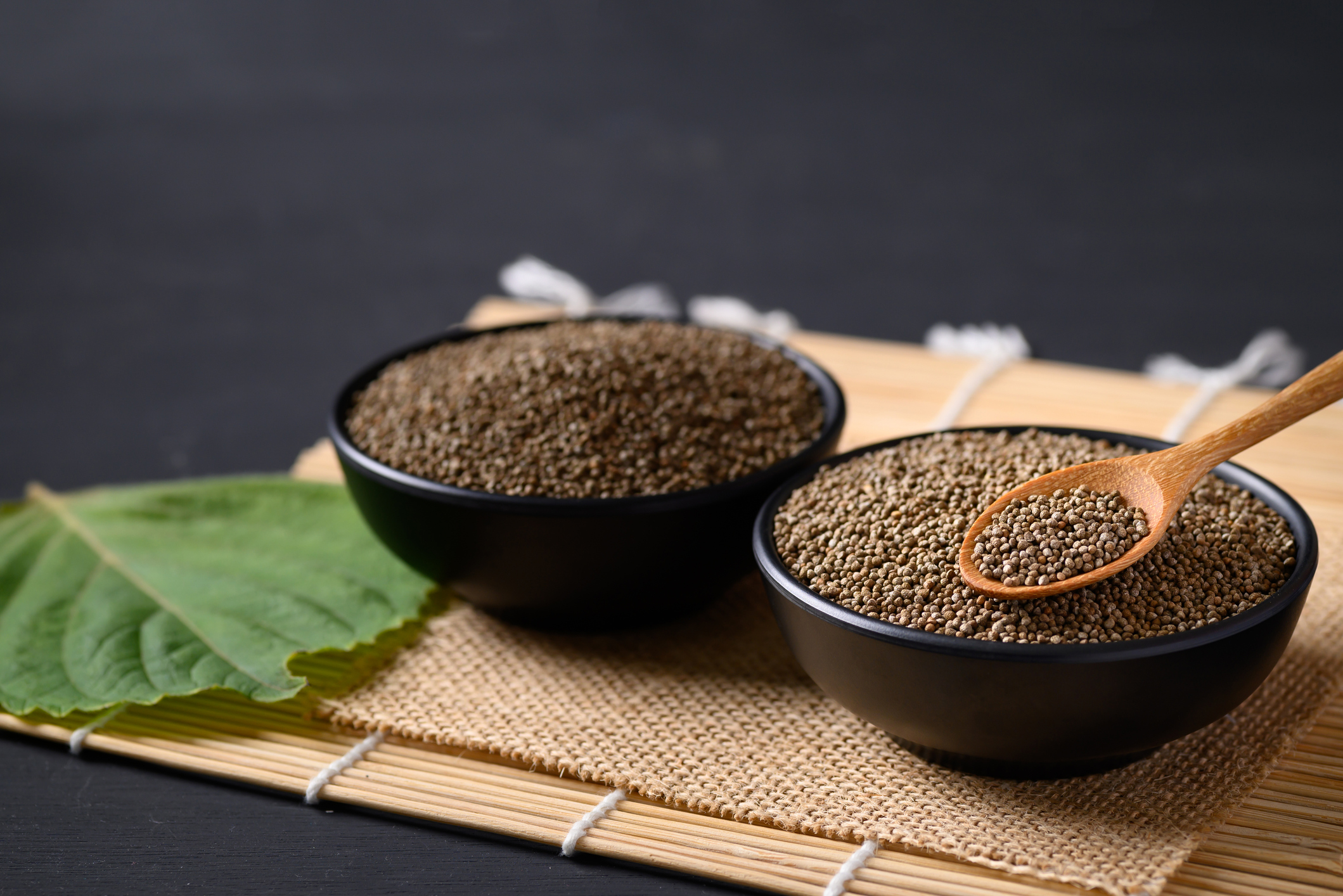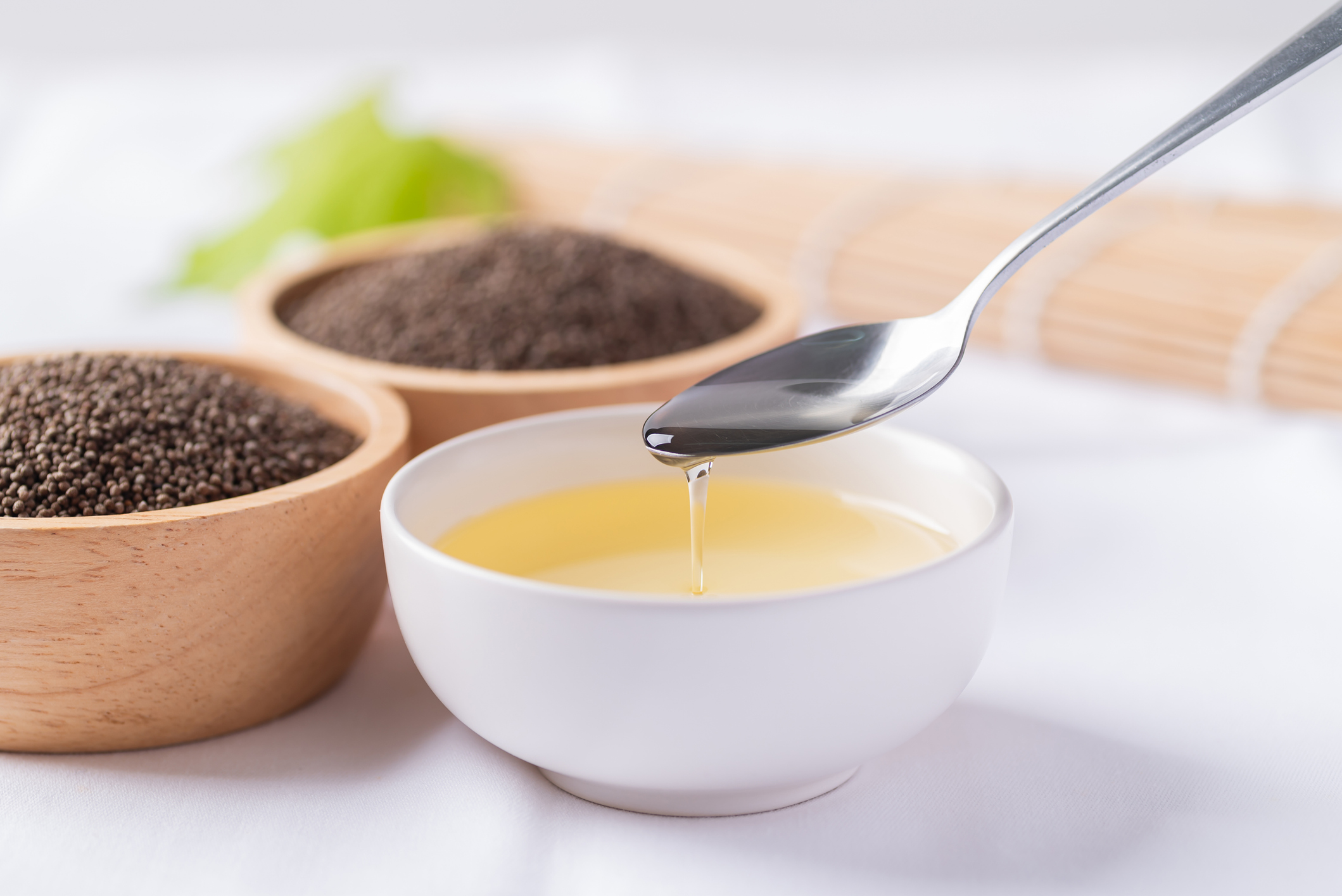| |
งาขี้ม้อน (Perilla) ธัญพืชมหัศจรรย์แห่งยอดเขา
งาขี้ม้อน (Perilla) มีชื่อวิทยาศาสตร์คือ Perilla frutescens (L.) Britton เป็นพืชน้ำมันล้มลุกที่เป็นสมุนไพรท้องถิ่นที่ปลูกมายาวนานในแถบภาคเหนือของไทย และยังพบได้ในพื้นที่อื่นๆ ในแถบเอเชียตะวันออก และเอเชียตะวันออกเฉียงใต้ เช่น จีน ญี่ปุ่น เกาหลี ลาว พม่า กัมพูชา รวมถึงแถบอื่นๆ เช่น อินเดีย เป็นต้น โดยงาขี้ม้อนถูกนำมาใช้ประโยชน์ตั้งแต่อดีตจนถึงปัจจุบัน (Ahmed, 2019; Makino et al., 2003; Yu et al., 2017) โดยเฉพาะการนำมาเป็นส่วนประกอบของอาหาร แปรรูปเป็นผลิตภัณฑ์อาหารต่างๆ รวมถึงการใช้เสริมรสชาติ และหน้าตาของอาหารด้วย แม้กระทั่งในปัจจุบันนี้ งาขี้ม้อนก็ยังเป็นที่นิยมในการใช้เป็นหนึ่งในองค์ประกอบที่สำคัญของอาหารที่อุดมไปด้วยสารอาหารที่เราได้ยินกันว่า “ซุปเปอร์ฟู้ด (Superfood)” เพื่อสุขภาพที่หลากหลายอีกด้วย นอกจากนั้นแล้วในบางพื้นที่ เช่น จีน และอินเดีย ยังใช้ส่วนต่างๆ เช่น ใบ ลำต้นและเมล็ดจากงาขี้ม้อนในการบรรเทาอาการป่วยบางอย่าง เช่น อาการไข้ โรคที่เกี่ยวกับภาวะซึมเศร้า ความวิตกกังวล ความผิดปกติของลำไส้บางชนิด การบรรเทาอาการปวดต่างๆ และการป้องกันการแท้งบุตร เป็นต้น (Ahmed, 2019; Kim et al., 2007; Makino et al., 2003; Yu et al., 2017; Zhou et al., 2014)

สำหรับในเมล็ดของงาขี้ม้อนนั้นเป็นส่วนที่อุดมไปด้วยน้ำมันที่มีองค์ประกอบหลักเป็นกรดไขมันต่างๆ ที่มีประโยชน์ต่อร่างกายโดยเฉพาะอย่างยิ่งกรดไขมันไม่อิ่มตัว (polyunsaturated fatty acids: PUFAs) โดยเมื่อเปรียบเทียบกับพืชชนิดอื่นๆ แล้ว ในเมล็ดงาขี้ม้อนถือได้ว่ามีกรดไขมันไม่อิ่มตัวในกลุ่มโอเมกา (omega fatty acids) ได้แก่ กรดไขมันโอเมกา-3 (กรดลิโนเลนิก หรือ linolenic acid) สูงที่สุดถึงราวๆ ร้อยละ 54-64 นอกจากนั้นแล้วยังประกอบไปด้วยกรดไขมันโอเมกา-6 (กรดลิโนเลอิก หรือ linoleic acid) อยู่ประมาณร้อยละ 11-16 และยังพบกรดไขมันโอเมกา-9 (กรดโอเลอิก หรือ oleic acid) ร้อยละ 14-23 (Asif, 2011) โดยกรดไขมันไม่อิ่มตัวในกลุ่มโอเมกา โดยเฉพาะโอเมกา-3 และ 6 นั้น มีประโยชน์อย่างมากในการช่วยเพิ่มความสมบูรณ์แข็งแรงของระบบหมุนเวียนโลหิต และ ยังช่วยส่งเสริมประสิทธิภาพของระบบภูมิคุ้มกันของร่างกายให้ดีขึ้นอีกด้วย (Asif, 2011; James et al., 2000; Longvah et al., 2000; Reisman et al., 2006) โดยมีงานวิจัยที่แสดงให้เห็นว่าสมดุลระหว่างกรดไขมันโอเมกา-3 และ 6 นั้น เป็นหนึ่งในหัวใจสำคัญของการที่ระบบภูมิคุ้มกันร่างกายทำงานได้อย่างปกติ (Mattson and Grundy, 1985; Simopoulos, 2002) มีงานวิจัยที่ได้ศึกษาถึงประโยชน์ของกรดไขมันโอเมกา-3 ที่พบในน้ำมันเมล็ดงาขี้ม้อนโดยเฉพาะ eicosapentaenoic acid (EPA) และ docosahexaenoic acid (DHA) ที่เป็นผลผลิตจากกระบวนการเมตาบอลิซึมของต้นงาขี้ม้อนและสามารถพบได้ในน้ำมันปลา พบว่าสามารถช่วยป้องกันโรคหัวใจและช่วยลดการแข็งตัวของเลือดได้ (Calder, 2004; Li et al., 2022; Lopez-Huertas, 2010; Mozaffarian and Wu, 2011) นอกจากนี้ กรดไขมันโอเมกา-3 และ 6 ยังถือว่าเป็นสารอาหารที่มีความสำคัญต่อการบำรุงสมองและระบบประสาทอีกด้วย (Asif, 2011; Green et al., 2007) อีกทั้งยังช่วยเพิ่มสมบัติในการต้านอนุมูลอิสระและป้องกันภาวะการทำงานของสมองและสภาวะจิตใจเสื่อมถอย (age-related cognitive and metal decline) ในผู้สูงอายุได้ (Hashimoto et al., 2021) รวมถึงการช่วยเพิ่มความหลากหลายของจุลินทรีย์ในลำไส้ (gut microbiota) ส่งผลให้สามารถบรรเทาอาการท้องผูกได้อีกด้วย (Kawamura and Sugita, 2023)

นอกจากนั้นแล้ว ในเมล็ดของงาขี้ม้อนยังอุดมไปด้วยสารสำคัญกลุ่มอื่นๆ ได้แก่ สารกลุ่มฟีนอลิก (phenolic compound) เช่น กรดคาเฟอิก (caffeic acid) กรดโรสมารินิกและอนุพันธ์ (rosmarinic acid and derivatives) กรดเฟอรูลิก (ferulic acid) กรดวานิลลิก (vanillic acid) เป็นต้น และสารกลุ่มฟลาโวนอยด์ (flavonoid compound) เช่น คาเทชิน (catechin) เอพิจีนินและอนุพันธ์ (apigenin and derivatives) ลูทีโอลินและอนุพันธ์ (luteolin and derivatives) ที่มีสรรพคุณที่โดดเด่นในด้านการเป็นสารต้านอนุมูลอิสระที่มีประสิทธิภาพสูง (Gu et al., 2009; Kang and Lee, 2011; Kim and Lee, 2019; Meng et al., 2009; Peng et al., 2005; Yamazaki et al., 2003; Zhou et al., 2014) จากข้อมูลงานวิจัยต่างๆ นี้ จึงถือได้ว่าน้ำมันงาขี้ม้อนที่สกัดมาจากเมล็ดงาขี้ม้อนนั้น เป็นอีกแหล่งสารอาหารจากพืชที่อุดมไปด้วยสารโภชนเภสัชที่มีศักยภาพสูง และถูกเลือกให้เป็นหนึ่งในองค์ประกอบของ “ซุปเปอร์ฟู้ด” และทางทีมวิจัยของบริษัท อยู่ นาน นาน จำกัด ก็ได้เลือกน้ำมันงาขี้ม้อนมาเป็นส่วนสำคัญในผลิตภัณฑ์นวัตกรรมอาหารเสริมคุณภาพสูงเพื่อส่งต่อสารอาหารและสารโภชนเภสัชที่ประสิทธิภาพสูงเหล่านี้ผ่านเทคโนโลยีเฉพาะของเราไปสู่ผู้บริโภคอีกด้วย
เรียบเรียงโดย ทีมวิจัย บริษัท อยู่ นาน นาน จำกัด
เอกสารอ้างอิง
- Ahmed, H.M., 2019. Ethnomedicinal, Phytochemical and Pharmacological Investigations of Perilla frutescens (L.) Britt. Molecules.
- Asif, M., 2011. Health effects of omega-3,6,9 fatty acids: Perilla frutescens is a good example of plant oils. Orient. Pharm. Exp. Med. 11, 51–59.
- Calder, P.C., 2004. n–3 Fatty acids and cardiovascular disease: evidence explained and mechanisms explored. Clin. Sci. 107, 1–11.
- Green, K.N., Martinez-Coria, H., Khashwji, H., Hall, E.B., Yurko-Mauro, K.A., Ellis, L., LaFerla, F.M., 2007. Dietary Docosahexaenoic Acid and Docosapentaenoic Acid Ameliorate Amyloid-β and Tau Pathology via a Mechanism Involving Presenilin 1 Levels. J. Neurosci. 27, 4385–4395.
- Gu, L., Wu, T., Wang, Z., 2009. TLC bioautography-guided isolation of antioxidants from fruit of Perilla frutescens var. acuta. LWT - Food Sci. Technol. 42, 131–136.
- Hashimoto, M., Matsuzaki, K., Hossain, S., Ito, T., Wakatsuki, H., Tanabe, Y., Ohno, M., Kato, S., Yamashita, K., Shido, O., 2021. Perilla Seed Oil Enhances Cognitive Function and Mental Health in Healthy Elderly Japanese Individuals by Enhancing the Biological Antioxidant Potential. Foods, 10, 1130.
- James, M.J., Gibson, R.A., Cleland, L.G., 2000. Dietary polyunsaturated fatty acids and inflammatory mediator production12. Am. J. Clin. Nutr. 71, 343S-348S.
- Kang, N.S., Lee, J.H., 2011. Characterisation of phenolic phytochemicals and quality changes related to the harvest times from the leaves of Korean purple perilla (Perilla frutescens). Food Chem. 124, 556–562.
- Kawamura, A., Sugita, M., 2023. Perilla Oil, An Omega-3 Unsaturated Fatty Acid-Rich Oil, Enhances Diversity of Gut Microbiota and May Relieve Constipation in Sedentary Healthy Female: A Nonrandomized Placebo-Controlled Pilot Study. Dietetics, 2, 191-202.
- Kim, D.H., Lee, J.H., 2019. Comparative evaluation of phenolic phytochemicals from perilla seeds of diverse species and screening for their tyrosinase inhibitory and antioxidant properties. South African J. Bot. 123, 341–350.
- Kim, M.-K., Lee, H.-S., Kim, E.-J., Won, N.-H., Chi, Y.-M., Kim, B.-C., Lee, K.-W., 2007. Protective effect of aqueous extract of Perilla frutescens on tert-butyl hydroperoxide-induced oxidative hepatotoxicity in rats. Food Chem. Toxicol. 45, 1738–1744.
- Li, J.-J., Dou, K.-F., Zhou, Z.-G., Zhao, D., Ye, P., Zhao, J.-J., Guo, L.-X., 2022. Role of omega-3 fatty acids in the prevention and treatment of cardiovascular Diseases: A consensus statement from the Experts’ Committee Of National Society Of Cardiometabolic Medicine. Front. Pharmacol. 13, 1069992.
- Longvah, T., Deosthale, Y.G., Uday Kumar, P., 2000. Nutritional and short term toxicological evaluation of Perilla seed oil. Food Chem. 70, 13–16.
- Lopez-Huertas, E., 2010. Health effects of oleic acid and long chain omega-3 fatty acids (EPA and DHA) enriched milks. A review of intervention studies. Pharmacol. Res. 61, 200–207.
- Makino, T., Furuta, Y., Wakushima, H., Fujii, H., Saito, K., Kano, Y., 2003. Anti-allergic effect of Perilla frutescens and its active constituents. Phyther. Res. 17, 240–243.
- Mattson, F.H., Grundy, S.M., 1985. Comparison of effects of dietary saturated, monounsaturated, and polyunsaturated fatty acids on plasma lipids and lipoproteins in man. J. Lipid Res. 26, 194–202.
- Meng, L., Lozano, Y.F., Gaydou, E.M., Li, B., 2009. Antioxidant Activities of Polyphenols Extracted from Perilla frutescens Varieties. Molecules, 14,133-140.
- Mozaffarian, D., Wu, J.H.Y., 2011. Omega-3 Fatty Acids and Cardiovascular Disease: Effects on Risk Factors, Molecular Pathways, and Clinical Events. J. Am. Coll. Cardiol. 58, 2047–2067.
- Peng, Y., Ye, J., Kong, J., 2005. Determination of Phenolic Compounds in Perilla frutescens L. by Capillary Electrophoresis with Electrochemical Detection. J. Agric. Food Chem. 53, 8141–8147.
- Reisman, J., Schachter, H.M., Dales, R.E., Tran, K., Kourad, K., Barnes, D., Sampson, M., Morrison, A., Gaboury, I., Blackman, J., 2006. Treating asthma with omega-3 fatty acids: where is the evidence? A systematic review. BMC Complement. Altern. Med. 6, 26.
- Simopoulos, A.P., 2002. The importance of the ratio of omega-6/omega-3 essential fatty acids. Biomed. Pharmacother. 56, 365–379.
- Yamazaki, M., Nakajima, J., Yamanashi, M., Sugiyama, M., Makita, Y., Springob, K., Awazuhara, M., Saito, K., 2003. Metabolomics and differential gene expression in anthocyanin chemo-varietal forms of Perilla frutescens. Phytochemistry 62, 987–995.
- Yu, H., Qiu, J.-F., Ma, L.-J., Hu, Y.-J., Li, P., Wan, J.-B., 2017. Phytochemical and phytopharmacological review of Perilla frutescens L. (Labiatae), a traditional edible-medicinal herb in China. Food Chem. Toxicol. 108, 375–391.
- Zhou, X.-J., Yan, L.-L., Yin, P.-P., Shi, L.-L., Zhang, J.-H., Liu, Y.-J., Ma, C., 2014. Structural characterisation and antioxidant activity evaluation of phenolic compounds from cold-pressed Perilla frutescens var. arguta seed flour. Food Chem. 164, 150–157.
|
|
